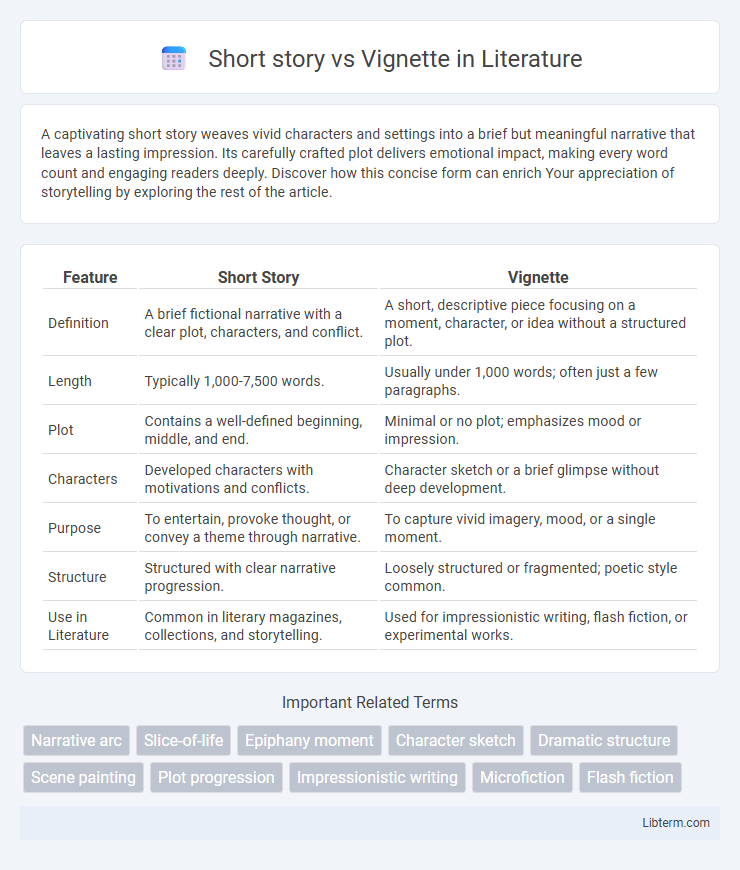A captivating short story weaves vivid characters and settings into a brief but meaningful narrative that leaves a lasting impression. Its carefully crafted plot delivers emotional impact, making every word count and engaging readers deeply. Discover how this concise form can enrich Your appreciation of storytelling by exploring the rest of the article.
Table of Comparison
| Feature | Short Story | Vignette |
|---|---|---|
| Definition | A brief fictional narrative with a clear plot, characters, and conflict. | A short, descriptive piece focusing on a moment, character, or idea without a structured plot. |
| Length | Typically 1,000-7,500 words. | Usually under 1,000 words; often just a few paragraphs. |
| Plot | Contains a well-defined beginning, middle, and end. | Minimal or no plot; emphasizes mood or impression. |
| Characters | Developed characters with motivations and conflicts. | Character sketch or a brief glimpse without deep development. |
| Purpose | To entertain, provoke thought, or convey a theme through narrative. | To capture vivid imagery, mood, or a single moment. |
| Structure | Structured with clear narrative progression. | Loosely structured or fragmented; poetic style common. |
| Use in Literature | Common in literary magazines, collections, and storytelling. | Used for impressionistic writing, flash fiction, or experimental works. |
Defining Short Stories: Key Characteristics
Short stories are brief fictional narratives typically ranging from 1,000 to 7,500 words, emphasizing a singular plot, focused characters, and a concise theme. They employ a clear structure with a beginning, middle, and end, designed to evoke a specific emotional response or insight. Unlike vignettes, short stories provide a complete narrative arc with conflict and resolution, making them distinct in both form and storytelling purpose.
Understanding Vignettes: Essential Features
Vignettes are brief, impressionistic scenes that capture a moment, mood, or character insight without a traditional plot or resolution. Unlike short stories, which typically follow a structured narrative with a beginning, middle, and end, vignettes emphasize atmosphere and detailed imagery to evoke emotion or highlight a theme. Understanding vignettes involves recognizing their focus on vivid description and subtle storytelling rather than complete narrative arcs.
Purpose and Intent: What Drives Each Form
Short stories aim to convey a complete narrative arc, focusing on character development, conflict, and resolution to engage readers and evoke emotional responses. Vignettes capture a brief moment, mood, or impression without traditional plot structure, emphasizing atmosphere and sensory detail over action. The purpose of a short story centers on storytelling and transformation, while vignettes prioritize deep, often poetic explorations of a single scene or feeling.
Structure and Plot Differences
A short story typically features a clear, structured plot with exposition, rising action, climax, and resolution, offering a complete narrative arc. In contrast, a vignette emphasizes a brief, impressionistic scene or moment without a traditional plot, focusing on atmosphere, character, or theme rather than a full storyline. The short story's structure drives character development and conflict resolution, while the vignette relies on vivid imagery and mood to evoke emotions or ideas.
Character Development Approaches
Short stories typically employ detailed character development through plot-driven events, allowing characters to evolve over time with clear motivations and conflicts. Vignettes focus on brief, vivid snapshots, emphasizing mood and momentary insights rather than extensive character arcs. This results in vignettes providing subtle, often indirect character impressions that invite readers to infer deeper traits.
Use of Setting and Atmosphere
Short stories often use setting to establish a detailed backdrop that drives plot development and character interactions, creating a vivid and immersive atmosphere. Vignettes emphasize a brief, focused moment or impression, using setting sparingly to evoke mood and highlight emotional resonance rather than advancing a narrative. The atmosphere in short stories tends to evolve with the storyline, while vignettes rely on a static, evocative setting to capture a singular feeling or insight.
Narrative Style and Voice
Short stories employ a structured narrative style with a clear beginning, middle, and end, often using a consistent voice that develops characters and plots. Vignettes focus on snapshot-like scenes or moments, emphasizing atmosphere and emotion without conventional plot progression, often using a more lyrical or impressionistic voice. The narrative style in vignettes is typically more fragmented and experimental, contrasting with the cohesive storytelling found in short stories.
Emotional Impact and Reader Engagement
Short stories build emotional impact through detailed plots and character development, allowing readers to form deep connections over time. Vignettes create immediate emotional resonance by capturing concise, poignant moments that evoke strong sensory or emotional reactions. Reader engagement in short stories relies on narrative progression, while vignettes engage through vivid imagery and thematic intensity.
Ideal Contexts for Each Form
Short stories excel in contexts requiring detailed plots, developed characters, and narrative arcs, making them ideal for exploring complex themes and emotional depth. Vignettes suit settings where brevity and snapshot impressions create vivid, immediate experiences, often emphasizing mood or a single moment without extensive background. Writers seeking to engage readers with layered storytelling often choose short stories, while those aiming for poetic, atmospheric glimpses prefer vignettes.
Choosing Between Short Story and Vignette
Choosing between a short story and a vignette depends on the writer's goal and narrative depth; short stories offer complete plots with character development and conflict resolution, while vignettes capture brief, evocative moments without traditional storytelling arcs. For conveying a snapshot of emotion or atmosphere, vignettes provide a powerful, concise form that emphasizes imagery and mood. Writers seeking to explore detailed characters and intricate plots benefit more from the structured format of short stories.
Short story Infographic

 libterm.com
libterm.com